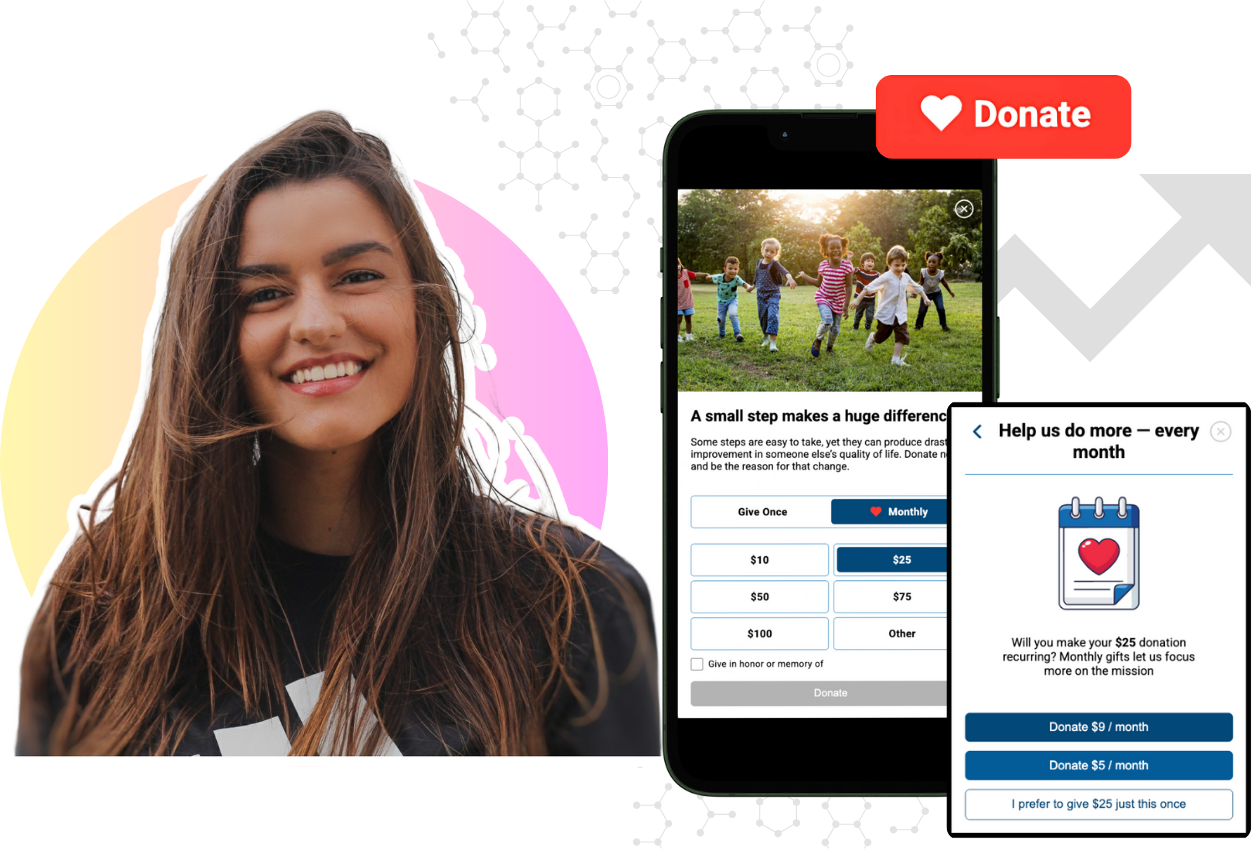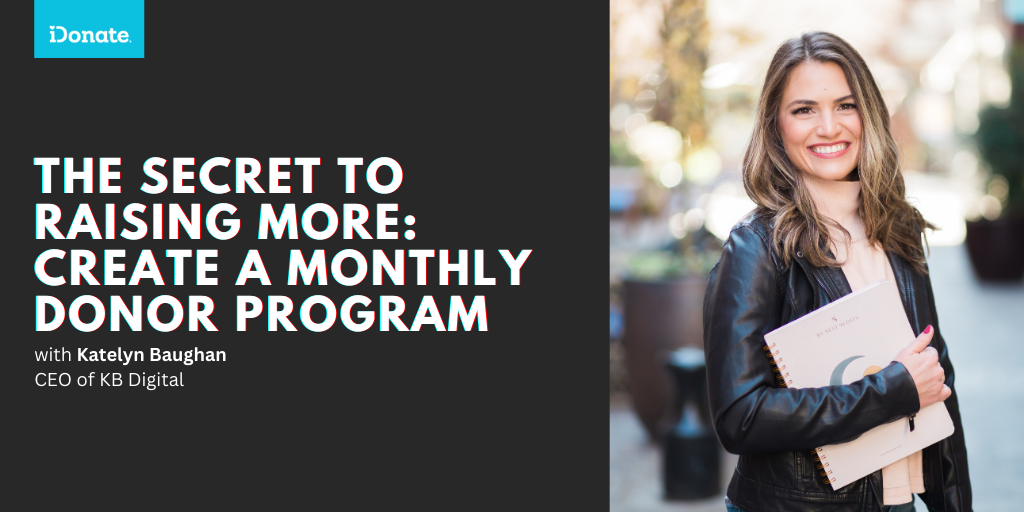5 Tips To Simplify Online Giving for the Donor
In order to simplify online giving, you need to simplify the donor’s user experience. The majority of donors are already giving online, and many more...

Mobile-First Pop-Up Donation Form
Launch mobile-first pop-up forms in minutes, use built-in tools to capture more donations, and optimize the giving experience—no dev team required.
New to online donation pages for your nonprofit? Start here.
Donation page A/B testing - no science degree needed.
Keep your donation page loading fast - and drive higher conversions.

The 4 Types of Online Donation Experiences
89% of donors leave without giving. Learn how to use the right donation form to close the gap and boost conversions.

Every NPO aspires to create a donor base that is recurring and sustainable. Nonprofits don’t close the loop well, which is why 75%-80% of donors don’t give a second gift. But “closing the loop” is no simple task. It requires several important steps that, once achieved, can make sustainable giving a reality. The process also allows management to thoroughly understand their current operations and where they need to improve their fundraising process.
One of the things closing the loop brings into sharp focus is whether and how effectively an NPO is communicating to donors about the impact their gifts are having for the cause they’re supporting. At the risk of sounding obvious, I know precisely why it matters to pay my electric bill every time I switch on a light or an appliance. I’m a satisfied customer.
I’m not comparing nonprofits to utilities. But if a donor can quickly, easily explain to someone the results that their giving is generating, you’re well on your way to closing the loop!
The steps emphasized here could be considered among the essential ingredients of sound, closed-loop fundraising. They address:
It all starts with potential donors and the discovery process. Whether you find them or they find you, being visible and easily found (one reason you need a solid SEO plan) are table stakes. The next phase, consideration, comes when a prospective donor studies and assesses the cause and the ask. This is where a comprehensive, compelling web presence counts.
Consideration is followed by the point of giving, where funds are collected. Each step of this process needs to be consistent in terms of the message, tone, look, and feel. The user experience, from the first click to checkout, needs to be friction-free and easy to understand. If you get this right, you’ve taken a big step in building trust with the donor.
After the donation is collected, the final step in the donor lifecycle is advocacy. This is a nonprofit’s first opportunity to acknowledge the good a donor has done and to reinforce the cause.
If closing the loop is to be fully realized, the process must extend from the start of the donor acquisition process to ongoing retention and conversion. That’s the real donor lifecycle.
It’s downstream in the value chain where NPOs commonly fall short. Converting an existing donor into a source of reliable, sustainable giving hinges on impact. To generate recurring donations, NPOs need to let donors see the impact that their gift is making.
It’s a simple, obvious fact that donors want to feel connected to the cause they support.
Instead, NPOs are often focused purely on getting donor dollars. They tend to see the collection of money from that newly acquired donor as the final step. They then fail to do a good job of telling the story about what happens after donations are received.
Closing the loop can only be brought about when the donor lifecycle is seen as a two-stage model. Stage 1 ends with collection. That’s when Stage 2 needs to be activated. The point of Stage 2 is to weave an ongoing, steady connection to donors such that they know what the nonprofit is doing over the course of a year and, most importantly, they are made clearly aware of the impact their giving is having.
No less important in closing the loop is assessing whether, and to what extent, you are seeing the future of donor communications clearly and are ready to act on it. If you don’t already know, you need to understand that the future of giving is digital and highly personalized.
And digital, more so today than ever, means mobile phones:
For too long, NPOs have operated in a very transactional way: reach out to prospects, get a gift, add that donor to your CRM, and reach out again in a year. NPOs need to build relationships with donors throughout the year using targeted personalized messaging, across devices (desktop, mobile), and on the channels that donors frequent on a daily basis.
Personalized messages are half the equation. The other half requires that you send them at the right time, or they’ll go ignored. Through data and learning, you can formulate a strategy that will help you effectively target your donor in the way that they want to receive your message at the time they are ready to receive it. Done consistently, this also encourages more opportunities to give throughout the year.
It merits repeating that nonprofits need to see giving from the donor’s perspective. For-profit businesses excel at this. They do so by putting data-driven insights to work to create an authentic “brand experience” that rewards loyalty and leads to retained relationships. By not employing a strategic fundraising playbook, nonprofits are leaving an estimated $36 billion in potential donations untapped.
However, that very same approach is well within the grasp of nonprofits, who have an opportunity to put the same playbook approach to work. The goal is to create an overall donor experience that fosters a new level of sustainable, recurring giving.
Successful businesses establish trust with consumers by cultivating a consistent brand presence, across all devices, channels, and touchpoints. Nonprofits can apply the same approach to create a donor experience by running “fundraising plays.”
Closing the loop for nonprofits hinges on building systems that enable an NPO to gather data every step along the donor lifecycle. This means having a clear picture of the larger strategy while zeroing in on what can be learned about the donor and knowing what to do next in order to create a sustainable giving loop.
iDonate designed its Digital Fundraising Platform (DFP) to enable just that. It provides a foundation upon which NPOs can strategically build and maintain relationships with donors at every touchpoint of the donor lifecycle throughout the year. Visit our site to learn more about the DFP and how it can help your organization close the loop.

In order to simplify online giving, you need to simplify the donor’s user experience. The majority of donors are already giving online, and many more...

When we think of online personalized experiences, there are many examples today such as Netflix offering suggested movies based on your viewing...

Nonprofit marketers and fundraisers all have one thing in common – they’re wearing way too many hats and are doing it all on a tight budget.